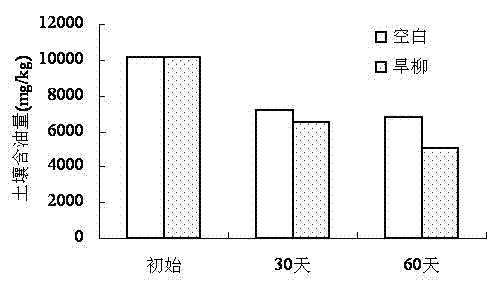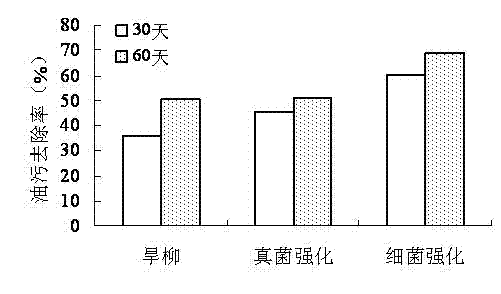Method for repairing oil-contaminated wetland by using plant salix matsudana
A wetland and oil pollution technology, applied in the restoration of polluted soil, climate change adaptation and other directions, can solve problems such as air pollution, and achieve the effect of small amount of engineering, low technical requirements and high degradation effect.
- Summary
- Abstract
- Description
- Claims
- Application Information
AI Technical Summary
Problems solved by technology
Method used
Image
Examples
Embodiment 1
[0021] Embodiment 1: dry willow phytoremediation of diesel polluted soil
[0022] Plant a willow plant (50cm high) in the soil, set up three parallel samples, and then directly put the oil-contaminated soil (blank) and the experimental sample outdoors. According to the abundance and shortage of soil moisture, water with a salinity of 0.2% is poured from time to time to saturate the soil with water. The experiment lasted 60 days. After 30 days and 60 days, soil samples were taken to measure the remaining diesel content, and their degradation rate and removal rate were calculated.
[0023] Experimental results: Willow has a strong tolerance to diesel pollutants. During the experiment on oily soil with a concentration of 10,000 mg / kg diesel oil, no toxic characteristics were found, and the plants grew well. From figure 1 It can be seen from the remaining residual oil in the soil samples after 30 days and 60 days that the dry willow has a high degradation effect on the diesel in...
Embodiment 2
[0024] Example 2: Oleophilic bacteria and fungi fortified willow to remediate diesel pollution
[0025] The original petroleum-contaminated soil used in the test was taken from the Huangpu River-Yangtze River estuary wetland soil, and the oil-loving bacteria and oil-loving fungi used in this experiment were sieved from it.
[0026] (1) culture medium
[0027] Screening Bacteria Medium: K 2 HPO 4 1g, KH 2 PO 4 1g, NaCl 0.5g, NH 4 (SO 4 ) 2 0.5g, MgSO 4 0.2g, KNO 3 0.2g, CaCl 2 0.02g, NaCl 0.5g, FeCl 3 Trace amount, distilled water 1000ml, pH 7.5. After sterilization, 10 g of diesel oil was added aseptically. Add 18.0g of agar to make bacterial diesel plate.
[0028] Screening media for fungi: NaNO 3 2.0g, K 2 HPO 4 1.0g, KCl 0.5g, MgSO 4 ·7H 2 O 0.5g, FeSO 4 ·7H 2O 0.008g, distilled water 1000ml, pH 7.0. After sterilization, 10 g of diesel oil was added aseptically. Add 18.0g of agar to make a fungus diesel plate.
[0029] Enrichment medium (g / L)...
PUM
 Login to View More
Login to View More Abstract
Description
Claims
Application Information
 Login to View More
Login to View More - R&D
- Intellectual Property
- Life Sciences
- Materials
- Tech Scout
- Unparalleled Data Quality
- Higher Quality Content
- 60% Fewer Hallucinations
Browse by: Latest US Patents, China's latest patents, Technical Efficacy Thesaurus, Application Domain, Technology Topic, Popular Technical Reports.
© 2025 PatSnap. All rights reserved.Legal|Privacy policy|Modern Slavery Act Transparency Statement|Sitemap|About US| Contact US: help@patsnap.com



